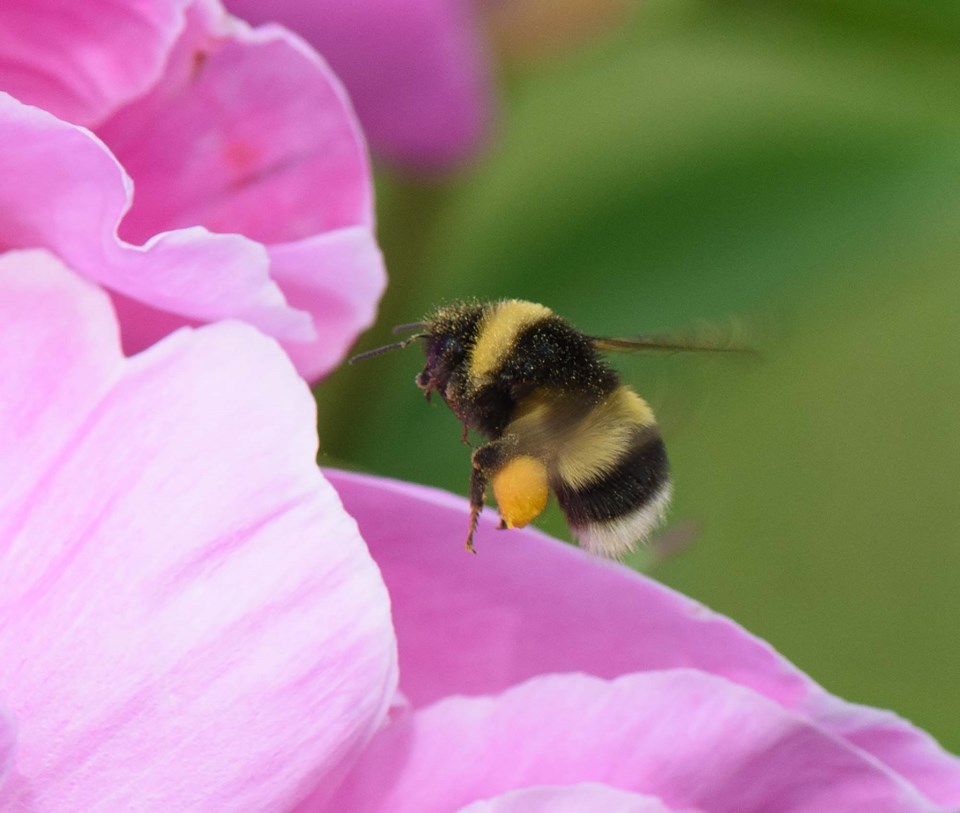Global heating could soon make it too hot for bumblebees to carry full loads of pollen, which could put their survival at risk, a new study suggests.
Malia Naumchik and Elsa Youngsteadt of North Carolina State University published a study May 17 in Biology Letters on how large pollen loads put bumblebees at greater risk of heat stress.
Bumblebees are cold-adapted insects that can shiver to warm up, said Youngsteadt, an associate professor of applied ecology. Bumblebee numbers are falling in areas warming up due to climate change, but researchers aren’t sure why — there’s little research available on how these bees tolerate heat.
Youngsteadt said Naumchik, then a student, had been collecting bumblebees as part of a different study and noticed that some of them had been carrying huge blobs of pollen. Naumchik said it must be a lot of work to haul those loads, and Youngsteadt agreed, saying that the bees likely got hotter as a result.
Youngsteadt said Naumchik decided to see if she could detect this temperature change — one that had been implied in previous studies but never detected in the wild.
Hot work
For this study, Naumchik and Youngsteadt caught common eastern bumblebees (Bombus impatiens) — a bee native to eastern North America used in Alberta greenhouses for pollination — just after they had visited flowers.
To catch the bees, they used a “bee-squeezer” — a small tube with one end open and the other covered with mesh, Youngsteadt said. They put the open end over a bee just after it had visited a flower and plugged the tube with a sponge, squeezing the bee against the mesh. They stabbed the bee with a tiny thermocouple thermometer, knocked it out with CO2, scraped the pollen off its legs with a toothpick-sized brush, froze bee and pollen, and weighed both. In a separate experiment, they put bees in tubes and heated them until they saw muscle spasms to determine their maximum heat tolerance.
The bumblebees in the study were found to carry up a third of their body weight in pollen at once. The bees worked in up to 55.8 C conditions, got as hot as 44.1 C, and had an average maximum heat tolerance of 46.6 C.
After controlling for weight and air temperature, Naumchik and Youngsteadt determined that a bumblebee’s risk of overheating increased as it carried more pollen, with every milligram of pollen raising their body temperatures by 0.07 C (presumably because they had to flap their wings harder and spent more time out in the heat). Fully loaded bees were 2 C hotter than unloaded ones — significant, as many big bees were foraging just a few degrees below their maximum heat tolerance. This suggests big bees carrying full loads could reach lethal temperatures on hot days.
“Bees were not falling out of the sky,” Youngsteadt said, so the bees were doing something to compensate for this heat — perhaps foraging earlier in the day or taking more breaks.
Youngsteadt said this study suggests that the added heat from carrying pollen is one way that global heating is harming bumblebees. Hotter conditions could make it tougher for bees to get pollen, which is what their larvae eat.
“If that activity becomes very limited, they might suffer population declines,” she said.
In addition to reducing heat-trapping pollution from fossil fuels, Youngsteadt said Albertans can help bumblebees weather global heating by planting lots of flowers and leaving messy patches in their yards as bee habitat.
Bumblebees are important pollinators for many plants, especially fruits and vegetables, said Lisa Neame, a board member with the Alberta Native Bee Council. This study shows the need for more research into how rising temperatures affect wild bees.
“It’s one thing to say climate change is affecting bumblebees negatively, but it gives us a lot more to work with if we actual have an idea of the kind of mechanism that might be contributing to that,” Neame said.




